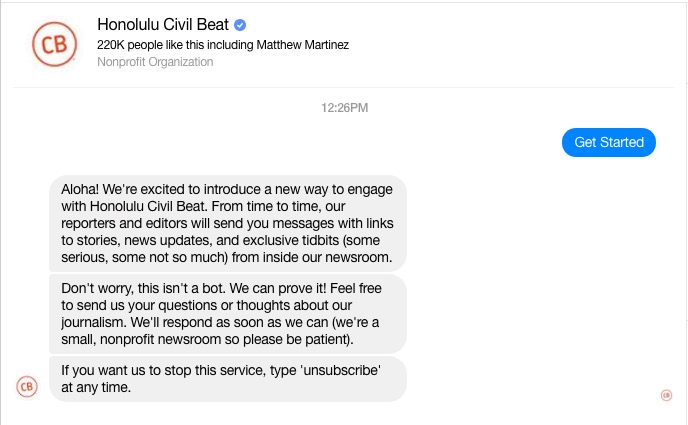
Bots on Facebook Messenger have been, at best, a mixed bag so far. When Facebook opened up Messenger to brands last April, the immediate — and unsurprising — reaction among publishers was to see the chat app as yet another distribution channel. The early “bot” experiments from CNN, Mic, and others were built around this conception, offering subscribers daily digests of top stories or other simple forms of push-based alerts.
Those rushed early ideas resulted in user experiences that did little to take advantage of the unique strengths of Messenger’s text-based interface. But more recent experiments show that news organizations are starting to realize the potential of Messenger and are using it to experiment with new kinds of talking to their readers.
Last month, Honolulu Civil Beat launched a chat bot designed around a few questions: How can a news organization use Messenger to start a genuine conversation with readers at scale? Can messaging be a viable way to field news tips from readers? And is there a better way to use Messenger to get stories out to people and make people more aware of the work that Civil Beat does?

The resulting product, while limited so far, offers a glimpse of Messenger’s evolving potential for news organizations, particularly small ones. When Facebook users message Civil Beat, the bot initially responds with a handful of automated messages that explain the idea behind the bot, links to a preview of the Civil Beat Monthly donor email (and donation link), and, lastly, asks if the user wants to sign up for the Civil Beat daily newsletter. Once users get through those initial prompts, someone from Civil Beat itself is able take over and field the user’s question or comment.
“It’s just another tool for us,” explained Anthony Quintano, Civil Beat’s engagement editor. “But it’s a very interesting one because it provides direct contact with people.” While readers are obviously already able to communicate with Civil Beat and its reporters via Facebook comments, email, and by phone, the site wanted to get to “get to the closest point where people could directly message us,” Quintano. “We want to be everywhere.”
Civil Beat, a newsroom of 20 with no in-house developers, worked with an external developer on the bot. Quintano said the size of the organization has forced it to be more creative with how it experiments with new ways of connecting with readers. The novelty and potential of the Messenger interface, coupled with the size of its readership on Facebook (216,400 users follow Civil Beat’s page) helped win over the organization. ProPublica, which has used Messenger to collect story ideas from readers, also cited those features for why it decided to create a bot. On the other hand, Facebook Messenger can be something of a sterile, impersonal way to engage with readers, as chat platform Purple recently discovered. Last year the company moved its entire operation to Messenger, whose backend and ties to the Facebook ecosystem it thought would make for a compelling value proposition for readers. A year later, lack of user interest has forced the service to leave Facebook Messenger entirely. (Rebecca Harris, Purple’s CEO and cofounder, suggested that some of the early, uninspired Facebook Messenger bots had poisoned the well for the projects that followed.)Early reader reaction to Civil Beat experiment has been mixed. Some said they found it annoying; some asked the bot itself whether such an idea was necessary. But Civil Beat also saw an encouraging number of people who thought it was an interesting project and embraced the idea of using it to communicate with the Civil Beat team. Some of these readers even used the bot to ask for help with Civil Beat videos they couldn’t find, while one reader asked the bot what kind of camera Civil Beat used to stream footage of a Monk Seal and its pup in July. “It’s been very impressive for the little we’ve done with it so far,” Quintano said.
But the most welcome development so far has been the number of readers who have used the Messenger bot to send Civil Beat news tips. While the site has always let people send it suggestions for things it should cover, Quantano said it was “pretty rare that we would actually get tips.” But within a few days of the bot’s launch, multiple readers were sending story ideas, questions, and, in some cases, photos of things they thought Civil Beat should cover.
For now, resource constraints prevent Civil Beat from further developing the bot, but Quintano the site is intrigued by what it’s seen so far, and is looking forward to expanding the idea over time. “We don’t know where this could take us. The goal is to find what potential there is as as far as reaching our readers and possibly getting some stories out of it.”